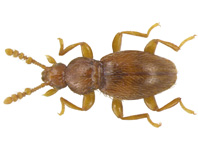Abstract
Three new earthworm species are described from South China, namely Amynthas rusticanus sp. nov., Amynthas scaberulus sp. nov., and Amynthas yuanjiangensis sp. nov. They are widely distributed in South China, and be polymorphic in reproductive organs. Of three new species, A. rusticanus sp. nov. is a small species with three pairs of spermathecal pores in 5/6–7/8 or two pairs of spermathecal pores in 5/6–6/7; it has developed prostate glands in XVI–XX. A. scaberulus sp. nov. is a medium-sized species with two pairs of spermathecal pores in 7/8–8/9; the lower edge of each spermathecal pore forms a tiny papilla, and the prostate glands are either degenerated or developed. A. yuanjiangensis sp. nov. is a medium-sized species with four pairs of spermathecal pores in 5/6–8/9 and has degenerated or developed prostate glands. Barcode data for each species (partial sequence of mitochondrial cytochrome c oxidase subunit I) are provided as well.
References
Blakemore, R.J. (2007) Updated checklist of pheretimoids (Oligochaeta: Megascolecidae: Pheretima auct.) taxa, Available from: http://www.annelida.net/earthworm/Pheretimoids.pdf (accessed 7 December 2020)
Blakemore, R.J. (2009) Cosmopolitan Earthworms—A Global and Historical Perspective. Wiley-Blackwell, Hoboken, 621 pp.
Chang, C.H. & James, S. (2011) A critique of earthworm molecular phylogenetics. Pedobiologia, 54 (Supplement S), S3–S9.
https://doi.org/10.1016/j.pedobi.2011.07.015
Chang, C.H., Lin, S.M. & Chen, J.H. (2008) Molecular systematics and phylogeography of the gigantic earthworms of the Metaphire formosae species group (Clitellata, Megascolecidae). Molecular Phylogenetics and Evolution, 49 (3), 958–968.
https://doi.org/10.1016/j.ympev.2008.08.025
Chang, C.H., Rougerie, R. & Chen, J.H. (2009) Identifying earthworms through DNA barcodes: Pitfalls and promise. Pedobiologia, 52 (3), 171–180.
https://doi.org/10.1016/j.pedobi.2008.08.002
Chang, C.H., Snyder, B.A. & Szlavecz, K. (2016) Asian pheretimoid earthworms in North America north of Mexico: An illustrated key to the genera Amynthas, Metaphire, Pithemera, and Polypheretima (Clitellata: Megascolecidae). Zootaxa, 4179 (3), 495–529.
https://doi.org/10.11646/zootaxa.4179.3.7
Dong, Y., Jiang, J., Yuan, Z., Zhao, Q. & Qiu, J. (2020) Population genetic structure reveals two lineages of Amynthas triastriatus (Oligochaeta: Megascolecidae) in China, with notes on a new subspecies of Amynthas triastriatus. International journal of environmental research and public health, 17 (5), 1538.
https://doi.org/10.3390/ijerph17051538
Folmer, O., Black, M., Hoeh, W., Lutz, R. & Vrijenhoek, R. (1994) DNA primers for amplification of mitochondrial cytochrome c oxidase subunit I from diverse metazoan invertebrates. Molecular Marine Biology and Biotechnology, 3 (5), 294–299.
Gates, G.E. (1956) Reproductive organ polymorphism in earth-worms of the Oriental Megascolecine genus Pheretima Kinberg 1867. Evolution, 10 (2), 213–227.
https://doi.org/10.2307/2405895
Gates, G.E. (1972) Burmese earthworms: An introduction to the systematics and biology of megadrile oligochaetes with special reference to Southeast Asia. Transactions of the American philosophical Society, 62 (7), 1–326.
https://doi.org/10.2307/1006214
Hall, T.A. (1999) BioEdit: a user-friendly biological sequence alignment editor and analysis program for Windows 95/98/ NT. Nucleic Acids Symposium Series, 41 (41), 95–98.
https://doi.org/10.1021/bk-1999-0734.ch008
Huang, J., Xu, Q., Sun, Z.J., Tang, G.L. & Su, Z.Y. (2007) Identifying earthworms through DNA barcodes. Pedobiologia, 51 (4), 301–309.
https://doi.org/10.1016/j.pedobi.2007.05.003
Muldal, S. (1952) The chromosomes of the earthworms: I. The evolution of polyploidy. Heredity, 6 (1), 56–76.
https://doi.org/10.1038/hdy.1952.4
Nguyen, T.T., Lam, D.H., Trinh, B.T.K. & Nguyen, A.D. (2020a) The megascolecid earthworms (Annelida, Oligochaeta, Megascolecidae) in the Phu Quoc island, Vietnam, with descriptions of three new species. ZooKeys, 932, 1–25.
https://doi.org/10.3897/zookeys.932.50314
Nguyen, T.T., Tran, B.T.T., Lam, D.H. & Nguyen, A.D. (2020b) Four new species of Amynthas earthworms in southeastern Vietnam (Annelida, Oligochaeta, Megascolecidae). Zootaxa, 4790 (2), 277–290.
https://doi.org/10.11646/zootaxa.4790.2.5
Sims, R.W. & Easton, E.G. (1972) A numerical revision of the earthworm genus Pheretima auct.(Megascolecidae: Oligochaeta) with the recognition of new genera and an appendix on the earthworms collected by the Royal Society North Borneo Expedition. Biological Journal of the Linnean Society, 4 (3), 169–268.
https://doi.org/10.1111/j.1095-8312.1972.tb00694.x
Sudhir, K., Glen, S., Michael, L., Christina, K. & Koichiro, T. (2018) MEGA X: Molecular Evolutionary Genetics Analysis across computing platforms. Molecular Biology and Evolution, 35, 1547–1549.
https://doi.org/10.1093/molbev/msy096
Sun, J., Jiang, J., Bartlam, S., Qiu, J. & Hu, F. (2018) Four new Amynthas and Metaphire earthworm species from nine provinces in southern China. Zootaxa, 4496 (1), 287–301.
https://doi.org/10.11646/zootaxa.4496.1.24
Thompson, J.D., Gibson, T.J., Frédéric, P., Franois, J. & Higgins, D.G. (1997) The CLUSTAL_X Windows Interface: Flexible Strategies for Multiple Sequence Alignment Aided by Quality Analysis Tools. Nucleic Acids Research, 25 (24), 4876–4882.
https://doi.org/10.1093/nar/25.24.4876
Xu, Q. & Xiao, N. (2011) Chinese terrestrial earthworm. China Agriculture Press, Beijing, 321 pp. [in Chinese]
Yuan, Z., Jiang, J., Dong, Y., Zhao, Q., Sun, J. & Qiu, J. (2020) Unearthing the genetic divergence and gene flow of the earthworm Amynthas_YN2017 sp.(Oligochaeta: Megascolecidae) populations based on restriction site-associated DNA sequencing. European Journal of Soil Biology, 99, 103210.
https://doi.org/10.1016/j.ejsobi.2020.103210
Zhao, Q., Zhang, M., Dong, Y. & Qiu, J. (2017) New Species of Megascolecidae (Oligochaeta) from Hainan Island, China. Annales Zoologici, 67 (2), 221–227.
https://doi.org/10.3161/00034541ANZ2017.67.2.003
Zhong, Y., Xu, X. & Wang, D. (1984) On a new species of the earthworm genus Pheretima and its reproductive organ polymorphism. Acta Zootaxonomica Sinica, 9 (4), 356–360.


